
Delmenhorst – Wesermarsch – Oldenburg-Land is an electoral constituency represented in the Bundestag. It elects one member via first-past-the-post voting. Under the current constituency numbering system, it is designated as constituency 28. It is located in northwestern Lower Saxony, comprising the city of Delmenhorst and the districts of Wesermarsch and Landkreis Oldenburg.

Cloppenburg – Vechta is an electoral constituency represented in the Bundestag. It elects one member via first-past-the-post voting. Under the current constituency numbering system, it is designated as constituency 32. It is located in northwestern Lower Saxony, comprising the Cloppenburg and Vechta districts.

Nienburg II – Schaumburg is an electoral constituency represented in the Bundestag. It elects one member via first-past-the-post voting. Under the current constituency numbering system, it is designated as constituency 40. It is located in central Lower Saxony, comprising the district of Schaumburg and most of the district of Nienburg.
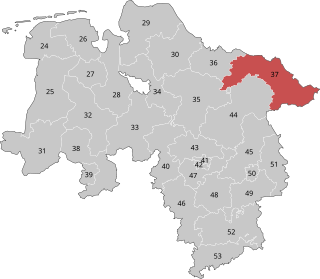
Lüchow-Dannenberg – Lüneburg is an electoral constituency represented in the Bundestag. It elects one member via first-past-the-post voting. Under the current constituency numbering system, it is designated as constituency 37. It is located in northeastern Lower Saxony, comprising the Lüchow-Dannenberg and Lüneburg districts.
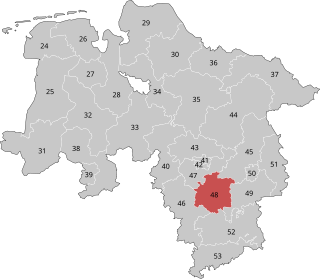
Hildesheim is an electoral constituency represented in the Bundestag. It elects one member via first-past-the-post voting. Under the current constituency numbering system, it is designated as constituency 48. It is located in southern Lower Saxony, comprising the district of Hildesheim.
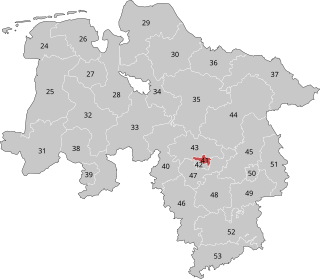
Stadt Hannover I is an electoral constituency represented in the Bundestag. It elects one member via first-past-the-post voting. Under the current constituency numbering system, it is designated as constituency 41. It is located in central Lower Saxony, comprising the northern part of the city of Hanover.
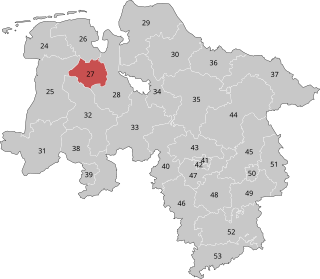
Oldenburg – Ammerland is an electoral constituency represented in the Bundestag. It elects one member via first-past-the-post voting. Under the current constituency numbering system, it is designated as constituency 27. It is located in northwestern Lower Saxony, comprising the city of Oldenburg and the district of Ammerland.

Salzgitter – Wolfenbüttel is an electoral constituency represented in the Bundestag. It elects one member via first-past-the-post voting. Under the current constituency numbering system, it is designated as constituency 49. It is located in southeastern Lower Saxony, comprising the city of Salzgitter, the district of Wolfenbüttel, and northern parts of the district of Goslar.

Celle – Uelzen is an electoral constituency represented in the Bundestag. It elects one member via first-past-the-post voting. Under the current constituency numbering system, it is designated as constituency 44. It is located in eastern Lower Saxony, comprising the districts of Celle and Uelzen.
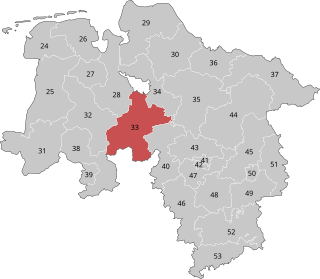
Diepholz – Nienburg I is an electoral constituency represented in the Bundestag. It elects one member via first-past-the-post voting. Under the current constituency numbering system, it is designated as constituency 33. It is located in central Lower Saxony, comprising the Diepholz district and parts of the Nienburg district.

Friesland – Wilhelmshaven – Wittmund is an electoral constituency represented in the Bundestag. It elects one member via first-past-the-post voting. Under the current constituency numbering system, it is designated as constituency 26. It is located in northwestern Lower Saxony, comprising the city of Wilhelmshaven and the districts of Friesland and Wittmund.

Gifhorn – Peine is an electoral constituency represented in the Bundestag. It elects one member via first-past-the-post voting. Under the current constituency numbering system, it is designated as constituency 45. It is located in eastern Lower Saxony, comprising the Peine district and most of the Gifhorn district.

Goslar – Northeim – Osterode is an electoral constituency represented in the Bundestag. It elects one member via first-past-the-post voting. Under the current constituency numbering system, it is designated as constituency 52. It is located in southern Lower Saxony, comprising most of the districts of Goslar, Northeim, and the former Osterode.

Göttingen is an electoral constituency represented in the Bundestag. It elects one member via first-past-the-post voting. Under the current constituency numbering system, it is designated as constituency 53. It is located in southern Lower Saxony, comprising most of the Göttingen district.

Hannover-Land II is an electoral constituency represented in the Bundestag. It elects one member via first-past-the-post voting. Under the current constituency numbering system, it is designated as constituency 47. It is located in central Lower Saxony, comprising the southern part of the Hanover Region.

Helmstedt – Wolfsburg is an electoral constituency represented in the Bundestag. It elects one member via first-past-the-post voting. Under the current constituency numbering system, it is designated as constituency 51. It is located in southeastern Lower Saxony, comprising the city of Wolfsburg, the district of Helmstedt, and part of the district of Gifhorn.
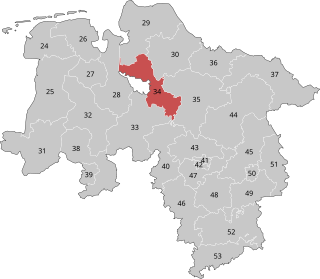
Osterholz – Verden is an electoral constituency represented in the Bundestag. It elects one member via first-past-the-post voting. Under the current constituency numbering system, it is designated as constituency 34. It is located in northern Lower Saxony, comprising the districts of Osterholz and Verden.

Stadt Osnabrück is an electoral constituency represented in the Bundestag. It elects one member via first-past-the-post voting. Under the current constituency numbering system, it is designated as constituency 39. It is located in western Lower Saxony, comprising the independent city of Osnabrück.

Neuss I is an electoral constituency represented in the Bundestag. It elects one member via first-past-the-post voting. Under the current constituency numbering system, it is designated as constituency 107. It is located in western North Rhine-Westphalia, comprising the southeastern part of the district of Rhein-Kreis Neuss.
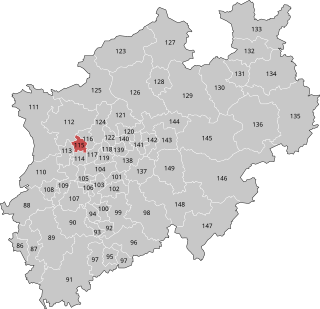
Duisburg II is an electoral constituency represented in the Bundestag. It elects one member via first-past-the-post voting. Under the current constituency numbering system, it is designated as constituency 115. It is located in the Ruhr region of North Rhine-Westphalia, comprising the northern part of the city of Duisburg.




















